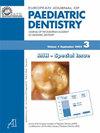Buccal Alveolar Bone changes and upper first molar displacement after maxillary expansion with RME, Ni-Ti leaf springs expander and Tooth- Bone-borne Expander. A CBCT based analysis.
IF 2.2
2区 医学
Q2 DENTISTRY, ORAL SURGERY & MEDICINE
引用次数: 0
Abstract
AIM To evaluate the buccal alveolar bone changes and the upper first molar displacement in subjects treated with conventional rapid maxillary expansion (RME), Ni-Ti leaf springs expander (Leaf Expander) and Tooth-Bone-borne Expander (Hybrid Expander) using CBCT scans. METHODS The sample consisted of 52 children treated with RME (n=18), Leaf Expander (n= 17) and Hybrid Expander (n= 17). CBCTs were taken before and after maxillary expansion and the Horos software was used for the analysis. Descriptive statistics and paired t-test were used to assess changes between the pre-treatment and post-treatment measurements. ANOVA test and Tukey's post hoc test with Bonferroni correction was used for between groups comparison. CONCLUSION The Hybrid Expander during preadolescence showed few advantages over the use of tooth-anchored expanders. An expansion approach with mini-screws is not preferable during early mixed dentition to a conventional approach. The differences in dental tipping values were clinically insignificant and the reduction in cortical bone thickness remained less than 1 mm. When possible, the use of second primary molars as anchorage should be preferred.RME、Ni-Ti叶弹簧扩张器和牙骨扩张器上颌扩张后牙槽骨变化和上颌第一磨牙位移。基于CBCT的分析。
目的:利用CBCT扫描评价常规快速上颌扩张器(RME)、镍钛叶弹簧扩张器(leaf expander)和牙骨扩张器(Hybrid expander)治疗后的颊槽骨变化和上颌第一磨牙位移。方法:52例患儿分别采用RME(18例)、Leaf Expander(17例)和Hybrid Expander(17例)治疗。分别在上颌扩张前后进行cbct扫描,使用Horos软件进行分析。使用描述性统计和配对t检验来评估治疗前后测量值的变化。组间比较采用方差分析(ANOVA)检验和Tukey’s事后检验(Bonferroni)校正。结论:混合扩展器在青春期前与牙锚定扩展器相比优势不大。在早期混合牙列中,与传统方法相比,迷你螺钉扩展方法并不可取。牙倾值的差异在临床上不显著,皮质骨厚度的减少仍小于1 mm。在可能的情况下,首选第二磨牙作为支抗。
本文章由计算机程序翻译,如有差异,请以英文原文为准。
求助全文
约1分钟内获得全文
求助全文
来源期刊

European journal of paediatric dentistry
DENTISTRY, ORAL SURGERY & MEDICINE-PEDIATRICS
CiteScore
4.60
自引率
19.40%
发文量
43
审稿时长
6-12 weeks
期刊介绍:
The aim and scope of the European Journal of Paediatric Dentistry is to promote research in all aspects of dentistry related to children, including interceptive orthodontics and studies on children and young adults with special needs.
 求助内容:
求助内容: 应助结果提醒方式:
应助结果提醒方式:


